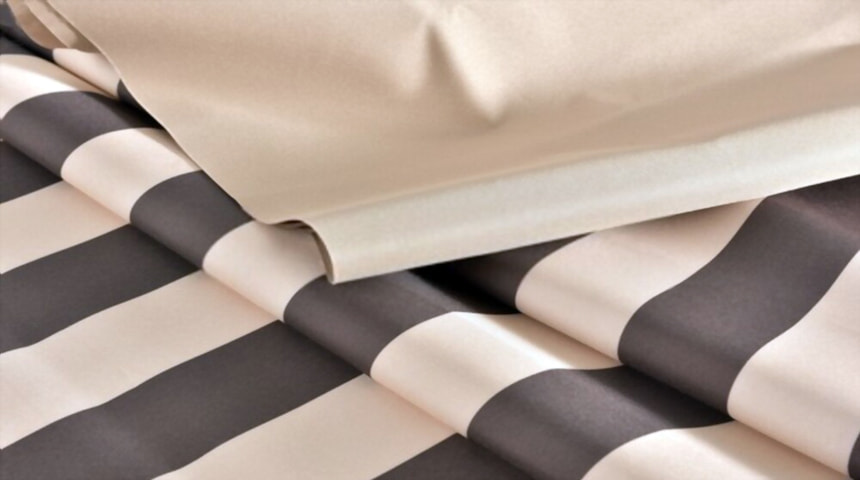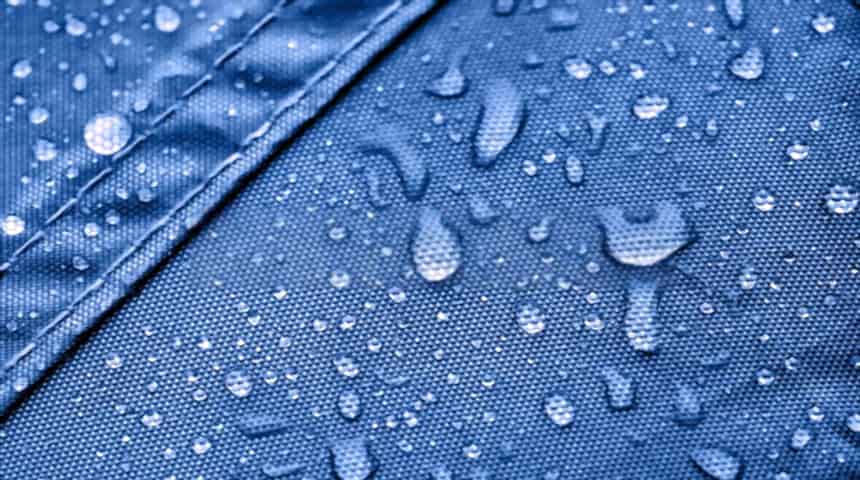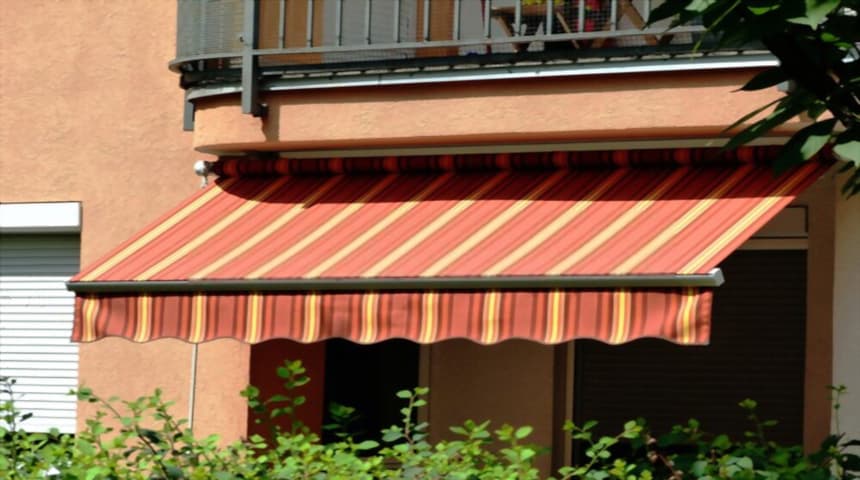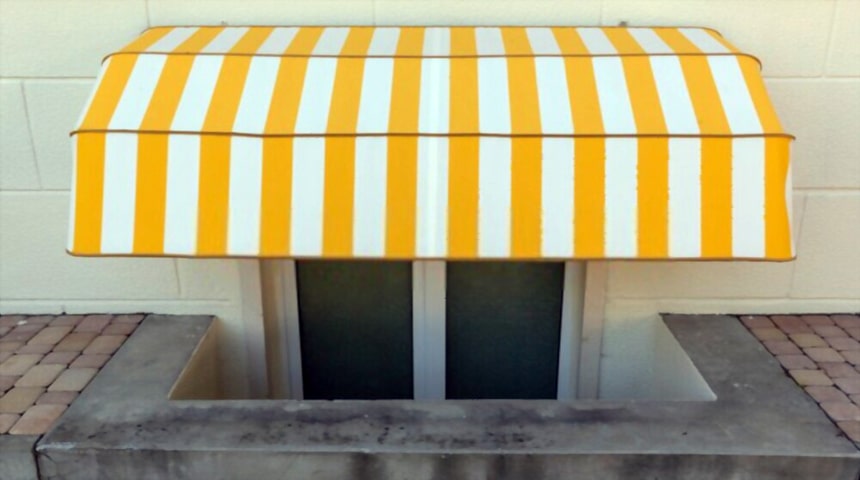Whether it’s a folding arm awning, a pergola awning or a facade awning, awnings are true all-round talents. They protect the terrace occupants from the sun and prying eyes, with integrated UV protection they ensure that garden furniture and upholstery do not fade and offer a protective canopy over your head in a light summer rain.
But are waterproof awnings suitable as rain protection, how much moisture can an awning withstand and what do you need to pay attention to?
Waterproof awnings are among the almost indispensable outdoor components. Thanks to their large-area fabric cover, they can shade larger areas consistently and effectively.
In addition, an awning on the terrace creates a homely atmosphere, privacy and intimacy. In principle, privacy and sun protection are the two main areas of application for which awnings were originally designed.
They are therefore only suitable as rain protection to a limited extent.
Waterproof outdoor awning fabric: protection against moisture through impregnation.
The good news first: a little rain will not damage a good waterproof outdoor awning. High-quality waterproof outdoor awnings are equipped with special weatherproof awning fabrics that can reliably repel a certain amount of moisture.
The reason for this lies in the high-tech material specially made for outdoor areas and the factory impregnation, which is standard for good waterproof awnings.
This impregnation not only provides basic protection against moisture, but also ensures that the waterproof awning fabric has dirt-repellent properties.
Dust, grease or oil are literally washed off the fabric, so that it does not fade permanently and looks well groomed.
For impregnation, nanotechnology-based substances are used, which ensure a “pearlescent effect”.
A particularly effective special treatment is the impregnation of the awning fabric surface with Teflon, as used for these types of awnings.
This form of impregnation has the advantage that not only the surface is protected, but the fibres of the awning fabric are also individually coated.
This increases the dirt and moisture repellent properties of the awning, so that the awning fabric is considered weather resistant.

Care of the fabric of patio awnings.
In principle, the impregnation of the patio awning fabric lasts a lifetime. However, its technical performance also depends to a large extent on the use and benefits as well as the correct application and can therefore diminish over the years.
If you notice that your patio awning tends to become soiled over time and the moisture no longer comes out as usual, you should first clean the awning.
Since the fabric of the patio awning is a special fabric, it can only be cleaned carefully and gently. To do this, first remove coarse dirt from the surface of the cloth with a hand brush or soft brush and then clean with a sponge and lukewarm water.
How to clean dirt from the awning?
For heavier soiling, you can add a little mild detergent to the water and spray the awning fabric with a garden hose.
Under no circumstances should you use a high-pressure cleaner. This can permanently damage the awning fabric. The awning fabric must then dry completely before retracting.
However, cleaning the waterproof awning fabric is only possible to a certain extent. After a certain age or degree of soiling, the only solution is to replace the cloth.
A re-impregnation can never be as homogeneous and effective as with the original equipment and is therefore not recommended.
How much rain can a waterproof sail awning withstand?
Anyone who has a waterproof sail awning has already experienced it: a cosy summer evening on the terrace and suddenly it started to rain. In the case of a brief, light rain, the mild evening is in most cases not disturbed by such a weather event.
Basically, however, the following applies: An awning is not designed as a rain protection and should therefore be retracted in case of heavy and persistent rain.
Depending on the type of fabric, there are also differences in the water resistance of waterproof sail awnings. The waterproofness of awning fabrics is measured in water pressure per millimetre, abbreviated as “mm/WS”.
This value indicates the water pressure resistance of a waterproof sail awning fabric with a medium impregnation and a pitch of 14 degrees, i.e. the rain tightness.
A standard value for awnings is between 350 and 450 mm/WS. In concrete terms, this means that the awning cover remains sealed during a short to medium rainfall.
Angles of inclination of awnings.
However, the angle of inclination at which the awning is mounted must be taken into account, as water can only run off the awning fabric if the angle of inclination is at least 14 degrees.
Waterproof awnings with a lower pitch angle are also watertight up to a certain amount of water, but water can accumulate quickly.
If water accumulates in the fabric of the awning, the awning will sag and the water pressure on the fabric increases sharply at certain points.
The consequences: the awning leaks in places and unsightly bulges form, so-called “water pockets”, which unfortunately often do not disappear.
To avoid this, you should retract the awnings at a lower pitch every time it rains to prevent permanent damage.

Leroy merlin waterproof awnings.
Good leroy merlin waterproof awning fabrics are considered water repellent due to their construction and surface treatment, but not waterproof.
Leroy merlin waterproof awnings that permanently protect against rain and moisture are called “rain awnings” and are mainly used in the catering industry.
In order to achieve the desired water resistance, leroy merlin awning fabrics are processed differently from conventional awning fabrics.
For example, the seams are ultrasonically welded and the fabric is often additionally coated on one side or the fabric is made of 100% waterproof PVC tarpaulin fabric.
However, these surface characteristics also have an effect on the awning fabric itself.
Leroy Merlin awnings are generally not very translucent and have poorer rolling properties because the fabric is heavier.
In addition, they are only available in limited designs. These are also the main reasons why rain awnings are rarely used in private areas on terraces and balconies.
General uses of the leroy merlin rain awning.
As a rule, a water-repellent leroy merlin rain awning fabric is sufficient for private use: it does not withstand hours of heavy rain, but in case of light rain, it reliably protects the terrace and residents from moisture.
However, if you want real and stable rain protection, you should consider a patio roof.
This permanently protects against rain, moisture and wind, so that outdoor living can be designed much more independently of the weather.
So that the area under the patio roof does not get too hot in summer, we recommend integrating a glazed patio awning into the patio roof.
The leroy merlin patio awning can be mounted above or below the roof.

Waterproof vertical awning and humidity: this is what you need to pay attention to.
Even if waterproof vertical awning fabrics are specially made for outdoor use, as textiles they are fundamentally susceptible to moisture damage.
These include the aforementioned bulges caused by standing water or mould stains.
In particular, if the fabric of the vertical waterproof awning is retracted in a damp state over a long period of time, fungi and lichen can even grow on the damp surface.
This affects the appearance of the waterproof awnings, the fabric can also become porous and the durability of the awning is significantly reduced.
Waterproof cassette awning.
The extent to which a cassette awning is exposed to the weather, even when retracted, depends to a large extent on the construction.
If the roll-up tube is exposed and unprotected, the fabric also suffers, which means that awnings lose stability and a cool appearance more quickly than, for example, cassette awnings.
With cassette awnings, the awning fabric, including the mechanism, is completely covered by a robust, weather-resistant cassette when retracted.
This protects the awning from moisture, snow and dirt from all sides. Open awnings can be upgraded with a rain cover as additional equipment.
Waterproof awning fabric.
However, the following applies to all waterproof awnings: if the waterproof awning fabric has become wet, it must be given the opportunity to dry completely.
To do this, you should immediately spread them out completely in sunny weather and let them dry so that no fungus or bacteria can settle on the wet surface of the awning fabric.
So-called wind, sun or rain monitors are also suitable for the intelligent protection of awning fabric against storms and moisture.
These are sensors integrated in the awning drive that react automatically to weather conditions.
For example, if no one is at home when a storm is approaching, a wind monitor protects the awning mechanism by automatically retracting the awning at a certain wind speed.
This process also occurs when it is raining if the rain monitor registers precipitation and thus protects the waterproof awning fabric.
In return, a solar monitor ensures optimum shade at all times. If certain light levels are registered, the automatic extension of the awning fabric ensures effective shading of the terrace.
Thus, also the air conditioning of the adjacent interior rooms, with the pleasant side effect that the awning does not remain wet rolled up after a rain shower, but can completely dry out again under the first rays of sunlight.
Waterproof fabric awnings in the rain: general rules.
Awnings made of waterproof fabric are basically designed as sun protection. Basically, the following applies:
Conventional awnings should not be used as rain protection and should always be retracted, especially in heavy rain!
However, a short, light shower cannot damage the awning, provided that the awning fabric has been treated with a suitable impregnation as moisture protection.
The angle of inclination of the awning must be taken into account. This should be at least 14 degrees so that water can drain off the awning fabric and there is no harmful accumulation of water.
Wet retracted waterproof fabric awnings should be extended immediately after rain to dry to prevent moisture damage such as mould and mildew stains.
Intelligent sensors, such as rain monitors, help to reliably protect the awning from moisture.

